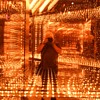Posted 9 years ago
 rniederman
rniederman
(346 items)
While I enjoy odd camera designs, there is something nice about simpler body patterns. This Waterbury View Camera, made by the Scovill Manufacturing Company, NY., is a classic representation of an American tailboard field camera.
Tailboard cameras were very popular, uncomplicated and elegant in appearance. They are basically a fixed front lens board attached to folding bed-rails with focusing done by moving the rear section portion back-and-forth on the rails.
This example is a 5 x 8 inch format model (for glass plates) constructed of nicely finished mahogany with brass hardware and a Scovill Waterbury marked brass barrel lens. A rotating disk adjusts the amount of light entering into the camera (f-stop adjustments).
The camera sold for $16.50 in 1892, or about $439.00 in year 2015 dollars.






































What is the purpose of the vertical moving front panel?
Great camera, love the look of brass & wood together!
Thanks, David and it's an excellent question. Unlike normal cameras, view cameras typically have ways to control image composition and distortion: swings, tilts, and shifts. What you are seeing is a rise-fall (shifting) lens board. It is especially useful when taking pictures of buildings or simply fine-tuning a composition.
As you probably know, pointing a camera up when photographing a building (such as a house) or trees will cause the object to look like it is disappearing in the distance (angular distortion). To avoid that, you would align the camera to the building (or trees) so that the lines stay parallel. The new problem is that the top part of the buildings or trees will be cut off and you end up with a lot of foreground.
To fix this, a shifting lens panel can 'rise' to change the portion of the image coverage to see the tops of buildings and trees. This can be done because lenses are designed to make image circle that is much larger than the film-plate format.
Also notice in the advertisement that the rear can be tilted. This is for distortion control. For instance, buildings and trees can be much too tall for a simple lens board rise and you have to point the camera up. Lines can be undistorted (returned to looking parallel) by tilting the board the holds the plate-film and so forth.
View cameras have a steep learning curve but it makes a lot of sense once you become acquainted with the concepts. I purchased my first view camera at the age of 17 and it's all instinctive to me (including understanding what's known as the Scheimpflug Rule).
Digital photography makes things a lot simpler. You can purchase perspective control lenses (very expensive) or simply correct distortion in software such as Photoshop, Lightroom and other products.
Thank you for the detailed response, It all makes sense when it is explained so well.
I always like studying old technology & am amazed at the ingenious ways that people arrived at a solution to the problem before them.
wow!! Rob you have a great collection and what a fabulous camera!!
Thanks, Michael!
Hi rniederman, as you might know now i also now, i work on a View cameras for 1887-1995, and B/W film and other film for company's.
Thanks!
racer4four
valentino97
fortapache
Thanks!
Sean
vetraio50
Thanks!
JohnK
Manikin
Ben
Thanks!
blunderbuss2
antiquerose
petey
Thanks!
farmlady
mtg75
Longings
Thanks!
kyratango
Designer
shughs
Thanks!
sanhardin
AntigueToys
glassiegirl
Thanks!
Manikin
Oroyoroyisthatyourhorse
Beachbum58
Thanks!
Trey
leighannrn
crswerner
Thanks!
f64imager
Chevelleman69
sugargirl
Thanks, Nicefice!
Thanks, chrissylovescats!
Thanks, Roycroftbooksfromme1!
Thanks, BCHMuseum!
Thanks, NevadaBlades!
Thanks, pops52!